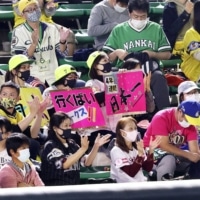Fukuoka – The third game of the 2020 Japan Series — which the Fukuoka SoftBank Hawks won 4-0 after nearly throwing a combined no-hitter to take a 3-0 lead in the series — almost felt like an actual Japanese baseball game.
Almost.
Holding a Japan Series in the middle of a pandemic hasn’t resulted in too many changes on the field. There, the NPB formula is largely the same — throw the ball, hit the ball, Hawks win. What’s missing is the overall atmosphere of a normal Japanese baseball game, which has been altered by the so-called new normal that has sprang up in the wake of the COVID-19 crisis.
Just as players adjusted to PCR testing and other measures in order to have a season, fans have also had to adapt. Through three games of this year’s Series, the crack of the bat has been the only sound more prevalent than the constant reminders to wear masks and follow the measures in place to help prevent the spread of the virus.
NPB has been asking fans to find new ways to cheer all season and refrain from singing and shouting — no small concession, as anyone who has been to an NPB game can tell you — and high-fiving those around them.
The fans have mostly done their part at the Japan Series. Instead of singing during each at-bat, they’ve clapped to the rhythm of drums being played in their cheering sections. Giants fans have been urged to hold up their various team-branded towels — but not swing them around — to show their support for the Kyojin. It made the first two games at Kyocera Dome a lot more quiet than usual.
The Hawks livened up the atmosphere in Game 3 at PayPay Dome, playing recorded versions of the usual songs as fans clapped along during SoftBank at-bats. The top of each inning was still quiet enough to hear Hawks third baseman Nobuhiro Matsuda shout various things after each pitch. The Hawks also have 20 performing Pepper robots stationed in the outfield, with 10 on either side of the batter’s eye in center.
Afterward, SoftBank manager Kimiyasu Kudo said he felt the fans’ energy.
“I think our players did too,” Kudo said.
There also aren’t as many fans, as government guidelines limiting attendance at large events have remained in place.
Instead of nearly 40,000 hanging on every pitch Matt Moore, Livan Moinelo and Yuito Mori threw as they carried the Hawks within an out of a combined no-hitter — Giants outfielder Yoshihiro Maru broke it up with a single up the middle — there were only 17,297 in attendance at Game 3. There were 37,194 at the same venue for Game 1 in 2019.
Not that the Hawks were complaining.
“It was such a great environment,” said Akira Nakamura, who had a two-run home run and an RBI single. “So we appreciate that.”
Most of the normal trappings of a baseball game were still present.
Cheerleaders and mascots performed on the field. Concession stands were open — fans were also reminded about social distancing — and the ubiquitous beer vendors darted up and down the aisles with kegs strapped to their backs as they scoured the seats for thirsty customers. The lack of singing and chanting made the experience closer to that of an MLB game.
Speaking of MLB, there were also limited crowds at the World Series between the Dodgers and Rays. MLB sold tickets in pods, with distance between the pods and no fan within 20 feet of the players.
At KBO’s Korean Series, which finished Tuesday with the NC Dinos beating the Doosan Bears in six games, fans had a slightly more restrictive experience than their NPB counterparts.
While the two leagues instituted similar edicts on cheering, fans at the Korean Series were not allowed to eat at their seats — there were tables set up in the stadium concourse — and weren’t allowed to drink alcohol in their seats, though drinks such as water and tea were allowed in the stands.
Another difference is while the World Series and Korean Series stuck to one venue — Globe Life Field in Arlington, Texas, and Gocheok Sky Dome, in Seoul — the Japan Series has used two. Additionally, more fans have been allowed at the Japan Series, with Games 1 and 2 each drawing over 16,000, compared to highs of 11,472 at the World Series and 8,200 in Korea.
In Japan, the players are completely cut off from the fans and even the majority of the media covering the series. Temperature checks and apps that can aid in contact tracing are the new normal and rarely does more than a few minutes go by where everyone isn’t reminded to wear masks.
The fans have lived with this since July, though there have been a few hiccups along the way. Hawks and Giants supporters at the Japan Series have done what has been asked of them in the stands for the most part. For that, they deserve a round of applause — just don’t literally sing their praises.
In a time of both misinformation and too much information, quality journalism is more crucial than ever.
By subscribing, you can help us get the story right.
Source : Baseball – The Japan Times
